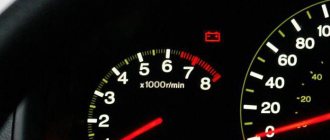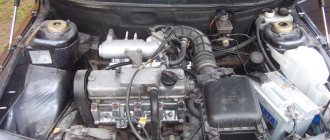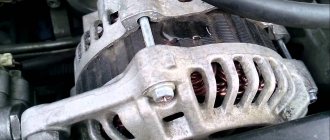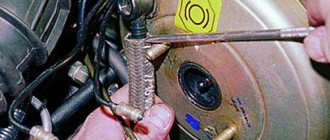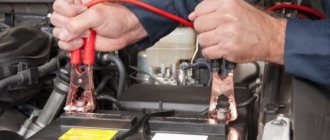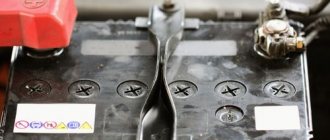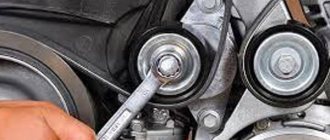A car battery can hardly be classified as equipment in which failures and malfunctions occur very often. But this cannot be ruled out.
The basis for reliable and efficient operation of the battery is maintaining an optimal charge level and the quality of the contact connections at the terminals.
During operation, motorists may notice that the contacts heat up. This is not considered normal, so it is important to determine the cause and try to eliminate it. On your own, or with the help of specialized specialists, is a secondary issue.
The positive terminal gets hot
Terminals are the current terminals for batteries. The vehicle's power supply wires are attached to them. They are made of lead.
If the positive contact on the battery heats up, this means that the wire has poor contact with the terminal. This may occur due to oxidation or due to water entering it.
Heating can cause ignition of wiring and a fire under the hood, melt insulation, and damage the battery case.
You can eliminate the causes of heating of the positive terminal as follows.
- Remove the end of the wire from the current terminal.
- Clean the contacts with sandpaper.
- It is advisable to change the wire that goes from the generator to the battery.
- Put the wire back on the terminal and sufficiently tighten the end of the wire that is connected to the current terminal on the battery.
To improve contact, it is necessary to select the desired ring diameter. Then the bolted connection will tightly grip the terminal and prevent this area from sparking and melting.
It is recommended to tighten the bolt nuts with two wrenches. This way you can avoid turning the bolt or nut.
If after cleaning the contacts a few days later a white oxide film of lead has formed again, which leads to poor contact between the wire and the battery, it is recommended to check the battery for electrolyte leakage. The battery may be deteriorating. Cracks have appeared on the battery body through which electrolyte vapors enter.
Video about battery terminals
Why does the negative cable on a car battery get hot? What is the reason for heating?
From my point of view, a wire or cable can heat up for two reasons:
- The wire is not designed for the load that falls on it, that is, the cable cross-section does not correspond to the actual load in the vehicle’s on-board network. Corrosion of the wire or its damage is possible, as a result of which its cross-section has locally decreased.
- Heating is possible due to poor contact in the electrical circuit. It is necessary to check all connections from the battery terminal to the junction of the negative wire with the ground (body) of the car. It is necessary to clean and stretch all questionable connections of the negative wire.
The safety of the electrical part of vehicles is one of the main aspects that should, first of all, concern the car owner. That is why excessive heating of the battery terminal is a serious signal for urgent elimination of the causes that cause it.
Types of battery terminals and their functions
Their second name - “current leads” - speaks for itself. It is to them that the power supply wires for the engine and the entire car are attached. The vast majority of battery terminal material is lead, and the dimensions are strictly standardized:
| Standard | Diameter (mm) | |
| Minus | Plus | |
| European | 19,5 | 17,9 |
| Asiatic | 12,7 | 11,1 |
On a note! There is also an American standard. It provides for a threaded connection of current leads to wires and allows the plus and minus terminals to be located on the side surface of the battery.
Why does the positive or negative contact get hot?
Along the section of the circuit between the battery, as well as the starter and generator, very large currents arise. And, for example, in the cold season they can reach 600 amperes. Any thin wire cannot handle such a current. Therefore, thick wires designed to withstand heavy loads are used.
There can be many reasons why the battery terminals may get hot. But in any case, this is some kind of malfunction in the electrical circuit of the vehicle. Experienced electricians know that with such symptoms, one should be wary of a short circuit in one of the connections. The cable may be damaged. It is necessary to find the problem and fix it.
The main reasons why the positive or negative terminal heats up may be the following:
- Poor contact with ground leads to heating of the negative wire due to increased load. To diagnose this problem, it is enough to increase the engine speed.
- Poor quality of the contacts themselves, which are usually purchased with the battery. In this case, both terminals can heat up at once.
- Over time, oxidative processes are inevitable. You can detect them by examining the terminals against the light - the presence of darkening or green marks indicates that they have oxidized and require cleaning.
- Another reason why the positive contact heats up is due to size mismatch. This may result in a loose connection.
- Mechanical damage to the cable in any area. Leads to loss of current supplied from the generator.
A situation often arises when there is not enough contact with the body. As a result, it is the negative terminal along with the wire that will overheat. The fact is that it is it that is grounded to the body, and then the starter and generator are powered from it. The reason may lie in the cable itself, although the driver mistakenly assumes that the current lead is to blame. But the positive contact usually overheats due to a poor connection or oxides formed.
How to avoid problems
Here are some simple recommendations that will avoid oxidation of terminals and contacts and save your nerves and battery:
- Inspection and cleaning of terminals. Regularly monitor the condition of the terminals, remove oxides, and ensure that all contact connections are free of dirt and dust. If there is still dirt and oxides, clean it. A brush with metal bristles, emery cloth, and a cloth with gasoline will help you;
- Good contact. Check all contact connections. If there is a leak somewhere or a lot of overheating due to differences in materials, replace it. Also tighten the cleaned terminal clamp that is placed over the terminal tightly.
- Inspect the battery and wiring. If you regularly carry out the previous steps, but oxides appear again and overheating occurs, make sure that your battery is not damaged and that no electrolyte gets on the contacts. Also check the integrity of the wiring and replace damaged pieces of cable.
The negative terminal gets hot
If the negative terminal gets hot, it is due to poor contact with the body. The latter is used in the form of grounding. Oxidation as a result of the release of electrolyte vapors to the outside can also affect.
To eliminate the causes of heating of the negative terminal, it is recommended to do the following:
- Check whether both ends of the wire are connected well enough.
- Clean the terminal from oxides with sandpaper. If oxides still remain, replace the battery with a new one.
Heating of the ground wire from the battery is not in itself dangerous if it occurs due to a poor connection. In case of oxidation and gradual destruction of the battery, this is dangerous for the lives of other components of the car, to which the problem can spread. The heat may cause the body to melt, which will lead to sulfuric acid leaking into the inside of the car.
What you need to know about terminals
To connect the contact groups of electrical equipment with the battery terminals, metal terminals are used.
These terminals are manufactured in accordance with international standards. They are divided into several types:
- type A;
- B;
- F;
- G;
- T;
- E;
The most common terminals are A and B, and most battery manufacturers use them. Made in the form of metal clamps, necessary for connecting the battery and consumers.
To ensure consistent quality contact, the connection is tightened with screws or bolts with an intermediate nut.
The terminal must meet some key requirements:
- large mass;
- high strength indicators;
- wear resistance;
- maintaining shape during deformation;
- simple design.
But even elements made in strict accordance with international requirements can periodically cause problems for car owners. One of these problems is contact heating.
Why does the positive or negative contact get hot?
During normal operation of the engine, a generator is constantly used, which charges the battery with a current of 10 A or more. The low resistance of the material prevents the contacts from heating up. If the built-in power source stops working, the battery takes over all currents. High load causes overheating of the terminals.
But more often it occurs when starting the engine. At this time, the starter must turn the engine shaft. The starting current increases and can reach 350 A in summer, 600 A in winter. The battery terminals heat up to high temperatures.
There are other reasons for heating:
- incorrect choice of conductor diameter;
- increase in temperature elsewhere;
- exceeding permissible currents.
Overheating of terminals.
If you select a conductive material with a smaller cross-section, overheating is possible. Heating occurs when contacts oxidize. When the bearings wear out, the starter will jam, which also leads to heating of the battery terminals. This also happens when the generator malfunctions.
Danger of heating battery terminals
Overheating of contacts is dangerous for the battery. An increase in temperature in the jars leads to intense evaporation of the electrolyte and shedding of the plates. The result is loss of battery capacity and battery failure. Frequent heating and cooling lead to the appearance of cracks on the walls of the housing. The defects gradually increase, and electrolyte leaks through the resulting hole. With strong heating (up to 300°C), the lead terminals will begin to melt.
Why does the battery fail?
Therefore, when understanding the problem of heating battery terminals, it would be more correct to look for an answer to the question of why a brand new battery died so soon. A battery can deteriorate for a number of reasons, for example:
- Warming up the terminal leads to heating of the current output (battery plate packs). They cause the distillate to evaporate, which causes the capacity to drop, which shortens the service life of the battery;
- The heated current lead melts the plastic case of the battery, as a result of which microcracks are formed, which cause leakage of electrolyte, which in turn can fall on the terminal, oxidize it and provoke even greater heating. As a result, the operation of the battery becomes impossible;
- The plastic case of the battery melted under the influence of high temperatures, the power source was completely damaged and can no longer be used.
You may be interested in: Is it possible to install a high-capacity battery in a car?
Remember that regardless of the true cause of the problem of heating the battery terminal, the risk of fire and fire increases!
The terminal gets hot: reasons
Both terminals get hot
If both terminals heat up when starting the engine or when turning on the wipers, heated mirrors or seats, this means that the generator cannot cope with the load. Energy is additionally taken from the battery. In case of poor contact, these places become very hot.
To avoid overheating of both terminals when starting up or connecting additional devices, you must repeat all the steps that were described above separately for the negative and positive contacts.
Attention! When working with a battery, you must follow safety precautions and use rubber gloves. If the battery leaks, there is a possibility of damaging exposed skin on your hands.
The wires coming from the battery get hot
It happens that the wire going to the charger gets hot. And the car owner thinks that this is a terminal.
The reasons for cable heating are as follows:
- small cable cross-section, which cannot withstand the load when connecting additional devices;
- break of several threads inside the cable;
- poor cable quality.
All this leads to the fact that the wires will heat up and may ignite. It is recommended to replace the cables with new and high-quality ones. Branded wires have passed European quality standards and have oil-, petrol- and heat-resistant insulation.
Important! It is best to connect the car battery terminals with a braided copper wire.
Boiling on the car
It is completely unacceptable if the battery boils while driving a car. This can lead to a fire; intense boiling of the electrolyte splashes it onto the car body, and it will then rapidly rust. Do not drive with a boiling battery - the battery may explode. Therefore, it is worth immediately identifying the causes and eliminating them.
Plate failure
The first thing that comes to mind is a faulty battery. Even if it is completely new, a manufacturing defect cannot be ruled out. The plates inside the battery may touch each other due to the battery freezing in winter - the electrolyte of a discharged battery contains little acid. When water freezes, it deforms the plates.
Over time, the lead plates wear out, and sediment that falls to the bottom of the jars shorts out the plates.
A failed bank causes a voltage drop at the battery terminals, and the standard generator current becomes unnecessary. The remaining banks undergo a recharging process.
In maintenance-free batteries, you can unscrew the caps and compare the boiling in the jars. If there is no boiling in one, then the battery can be scrapped.
You can also measure the voltage on a charged battery and the density in the banks. If the voltage is significantly lower than 12 volts and the density is uneven, the battery is most likely faulty.
Strong discharge
If you start a car using the “lighting” method with the battery installed, a strong electric current flows from the generator to it. The process of releasing electrons from sulfuric acid cannot proceed so intensely, and part of the energy is spent on decomposition of water and heating.
A heavily discharged battery (if the voltage is below 9 volts) should be charged with low currents in stationary conditions; it is advisable to use high-tech automatic chargers.
Fast charging from a car generator can damage the diode bridge and the generator relay regulator, as the load increases sharply.
Recharge during operation
The higher the vehicle speed, the more current the alternator can produce. The relay regulator is designed to limit the voltage corridor. This small semiconductor device prevents the vehicle current from exceeding the permissible parameters, which for most passenger cars is 14.5 volts.
If the relay regulator fails, the battery is recharged. Excess current decomposes water, vapor comes out, and electrolyte splashes out. The level drops and the plates are destroyed.
Diagnosing the relay regulator is simple - just measure the voltage of the on-board network. If it exceeds 14.6 volts (there are exceptions), then the movement must be stopped and the “chocolate bar” replaced - this is what the relay is called in the language of car mechanics.
Incorrect installation when batteries are paired
Some commercial vehicles and buses have two batteries installed to make starting easier. Owners of such cars know that two batteries need to be changed at once, otherwise the new one will quickly fail, and the old one will “drain” it while parked.
Boiling of a more powerful battery in such systems is a common occurrence, so you should install either one battery of increased capacity, or two of the same characteristics.
This is interesting: Detailed review of the IMax B6 mini charger
Why does my phone battery heat up when charging?
Most often, phone owners’ concerns about this have no serious basis:
- If the phone is charging and there are no obvious signs of overheating, then charging can be safely continued: all mobile phones “heat up” when connected to the network .
- If you make calls, play games or text while your phone is charging , its temperature will naturally be an order of magnitude higher than normal. In this case, you can wait for the device to finish charging so as not to worry again.
- If the body of your gadget is made of metal , it will heat up more, but there is no danger in this.
- When connecting to a smartphone Wi-Fi or any type of mobile Internet, downloading data will affect the temperature level during charging.
- The phone may heat up due to errors in the firmware system (program code). In this case, try to find an updated firmware version on the Internet.
- check the heating level of your smartphone during charging using a utility like CPU-Z .
Thus, any battery heats up when charging. When it comes to a car battery, it is important to carry out timely monitoring of the process in order to avoid possible irreversible damage. If the phone heats up, most often the users’ worries are in vain. But if in doubt, the heating level of the battery during charging can always be checked using special programs.
The most likely causes of heating
On thematic forums, disputes periodically arise regarding the reasons that cause heating of conductors with zero potential when the phase wires of a household network are in normal condition. Despite numerous discussions on this issue, there are only three factors that can cause the negative impact in question:
- Low reliability of electrical contact.
- Influence of higher harmonics.
- Increased load to zero.
We propose to consider in detail each of the reasons listed above.
Low reliability of electrical contact
This reason is most typical for old wiring made of aluminum wires. The disadvantages of this material have been repeatedly described in other publications on our website, but it would not be amiss to briefly list them once again:
- The formation of an oxide film on the wire, which causes an increase in contact resistance.
- The plasticity of the material requires regular tightening of the joints.
- Overheating of aluminum wire increases its fragility.
Considering that attention is often paid to the electrical contacts of phase wires, the zero bus is often forgotten. As a result, the contact resistance increases over time, it heats up and sooner or later burns out.
To be fair, it should be noted that this problem can also occur with copper wires. An example of poor contact with the zero bus in the apartment panel is shown in the photo.
Overheating of neutral wires due to poor contact
It is characteristic that the above problem most often manifests itself in residential panels, and not in electrical points. This is explained by the fact that the contact connections of the wires with the zero bus bear a greater load than a separate socket.
Influence of higher harmonics
With the advent of a large number of electrical appliances equipped with switching power supplies in everyday life and offices, a problem arose with overheating and, as a consequence, destruction (burnout) of the working zero wire. This occurs due to the latter being overloaded with higher harmonic currents. That is, a situation arises in which the zero carries more current than the phase conductors. In this case, the installation of protective devices is often carried out only on the latter.
With the advent of a large number of electrical consumers creating nonlinear loads, there is an increase in the current flowing through the working zero. This can lead to the latter burning out in old power systems. Examples of household electrical appliances causing nonlinearity:
- Microwave, induction and electric arc furnaces.
- LED and gas-discharge light sources.
- All devices with switching power supplies.
- Inverter electric machines, etc.
In order to prevent zero loss due to the influence of higher harmonics, changes were made to some regulatory documents
As an example, we can cite GOST 30804.4.30 2013, which requires that in calculations take into account harmonics whose order is from the 40th and higher. In GOST 50571.5.52 2011 it is recommended to select the cable cross-section depending on the most loaded current-carrying core, while the current load of the working zero should also be taken into account
Unfortunately, the scope of the current article does not allow us to more fully explore the topic of higher harmonics, but we will definitely return to it in one of the subsequent publications on our website.
Increased load to zero
Sometimes you can hear that overheating of the zero wire is associated with increased load due to the connection of a neighbor to the PE bus for the purpose of stealing electricity. This option is interesting, but not feasible. In one of our publications, which described various designs of electric meters, their resistance to various methods of theft of electrical energy was considered. In particular, it discussed the option of using land as a working zero and explained why this method does not work on modern energy metering devices.
As mentioned above, in the neutral working wire the current can exceed the phase current only in cases of higher harmonics. Connecting a neighbor to zero (in your panel) will cause overheating of this wire if, as a result of such actions, poor contact is formed with the common bus.
Why does the neutral wire heat up and how to eliminate overheating?
Heating of an electrical wire is an abnormal phenomenon in the electrical system and is a dangerous, destructive process that leads to accidents and fires. Frequent heating occurs at a point with poor electrical contact due to high contact resistance, or overloading of the conductor with increased load due to an incorrectly selected cable cross-section. But there are cases when the neutral wire heats up more than the phase wire. Within this publication, we will try to understand the reasons for the heating of electrical wires.
Most often, the neutral wire is heated in the distribution board at the entrance to the house, and it can also be the heating of the neutral terminal on the input circuit breaker. In addition, heating is observed if you have plugs with fuses or automatic plugs installed. In this case, there are many more places with heating: screw terminals, threaded base and other places with poor contact.
Three main reasons for heating:
- Excessive electrical load.
- Poor contact due to loose terminal tightening.
- High contact resistance due to oxides or carbon deposits.
Another reason for heating the zero may be twisting copper and aluminum wires together, which in no case should be done. It is necessary to use special terminals, or connect through a bolted connection, where there will be a metal washer between dissimilar conductors.
How to deal with terminal heating?
To eliminate heating at the joints, the car owner should, first of all, take care of the serviceability of the electrical equipment. It is necessary to check the permissible current loads for conductors (replacement of electrical equipment components, installation of new elements can lead to an increase in consumption). If necessary, replace the conductive harnesses by increasing the total cross-section of the conductors.
Along with this, they solve the problem of ensuring a reliable connection to the battery terminals. Contact failure occurs due to:
- Selecting batteries with current lead types different from those recommended in the documentation. For example, installing a battery with “Type B” pins instead of European ones will require replacing the contact groups on the conductors or using adapters.
- Loose contact of live parts. In the terminals, displacement of the conductors due to vibrations is observed. On terminal clamps, the reasons may be residual deformation of parts or cracks, or incomplete compression of the jaws.
Constant monitoring is required; if problems are detected, the conductors in the terminals should be additionally crimped, it is advisable to solder the harness (this will reduce the influence of vibration). Damaged or inadequate parts must be replaced.
- Wear of the surfaces of parts. It leads to the formation of an air gap (air is a dielectric) and an increase in transition resistance. In addition, an increase in resistance is caused by a reduction in the area of contacting surfaces (resistance is inversely proportional to area).
The most likely causes of wear are unreliable fixation on the battery terminals, frequent disconnection/connection of the battery. In a mandatory strand, you should clamp the joints on the jaws until they stop (but without excessive force). It is advisable to check the surface and lightly grind it (for example, with sandpaper) every time it is disconnected.
